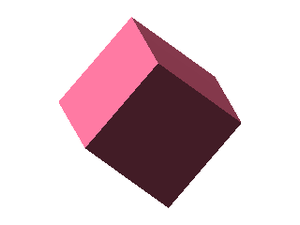Hard cube model: Difference between revisions
Carl McBride (talk | contribs) (Created page with "{{stub-general}} thumb|right '''Hard cube model''' ==References== <references/> '''Related reading''' *[http://dx.doi.org/10.1038/nmat2959 Umang Agarwal and...") |
Carl McBride (talk | contribs) (Added references to Truncated hard cubes section) |
||
| (4 intermediate revisions by 3 users not shown) | |||
| Line 1: | Line 1: | ||
[[Image:cube.png|thumb|right]] | [[Image:cube.png|thumb|right]] | ||
''' | The '''hard cube model''' models cube-shaped particles interacting purely through excluded-volume interactions. The phase behavior has been studied, for example see <ref>[http://dx.doi.org/10.1038/nmat2959 Umang Agarwal and Fernando A. Escobedo "Mesophase behaviour of polyhedral particles", Nature Materials '''10''' pp. 230-235 (2011)]</ref> | ||
<ref>[http://dx.doi.org/10.1073/pnas.1211784109 F. Smallenburg, L. Filion, M. Marechal, and M. Dijkstra "Vacancy-stabilized crystalline order in hard cubes", Proc. Natl. Acad. Sci. USA '''109''' pp. 17886-17891 (2012)]</ref>. | |||
The simple cubic crystal phase has been shown to contain a high number of mobile, delocalized vacancies, similar to those seen in [[Parallel hard cubes]]. | |||
==Implementation== | |||
Overlaps between cubes can be checked based on the [http://en.wikipedia.org/wiki/Hyperplane_separation_theorem separating axis theorem], which says that if two convex objects are not interpenetrating, there must be an axis for which the projections of the two objects will not overlap. In the case of two | |||
convex polyhedral particles, only a finite number of possible separating axes need to be | |||
checked: in that case, the possible separating axes are either parallel to a normal of one | |||
of the faces of either of the two particles, or perpendicular to the plane spanned by one | |||
of the edges of the first particle and one of the edges of the second particle. | |||
For two cubes, the overlap check therefore corresponds to the projection of both shapes onto 15 axes: the three edge vectors of both particles (6 in total), and the axes given by the 9 possible cross products of an edge vector of one cube with an edge vector of the other cube. The particles overlap if and only if the projections of the two particles on all 15 axes overlap as well. | |||
==Truncated hard cubes== | |||
<ref>[http://dx.doi.org/10.1103/PhysRevLett.111.015501 Anjan P. Gantapara, Joost de Graaf, René van Roij, and Marjolein Dijkstra "Phase Diagram and Structural Diversity of a Family of Truncated Cubes: Degenerate Close-Packed Structures and Vacancy-Rich States", Physical Review Letters '''111''' 015501 (2013)]</ref><ref>[http://dx.doi.org/10.1063/1.4906753 Anjan P. Gantapara, Joost de Graaf, René van Roij and Marjolein Dijkstra "Phase behavior of a family of truncated hard cubes", Journal of Chemical Physics '''142''' 054904 (2015)]</ref> | |||
==References== | ==References== | ||
<references/> | <references/> | ||
'''Related reading''' | '''Related reading''' | ||
*[http://dx.doi.org/10.1063/1.4734021 Umang Agarwal and Fernando A. Escobedo "Effect of quenched size polydispersity on the ordering transitions of hard polyhedral particles", Journal of Chemical Physics '''137''' 024905 (2012)] | *[http://dx.doi.org/10.1063/1.4734021 Umang Agarwal and Fernando A. Escobedo "Effect of quenched size polydispersity on the ordering transitions of hard polyhedral particles", Journal of Chemical Physics '''137''' 024905 (2012)] | ||
[[category: models]] | [[category: models]] | ||
Latest revision as of 12:38, 9 February 2015

The hard cube model models cube-shaped particles interacting purely through excluded-volume interactions. The phase behavior has been studied, for example see [1] [2]. The simple cubic crystal phase has been shown to contain a high number of mobile, delocalized vacancies, similar to those seen in Parallel hard cubes.
Implementation[edit]
Overlaps between cubes can be checked based on the separating axis theorem, which says that if two convex objects are not interpenetrating, there must be an axis for which the projections of the two objects will not overlap. In the case of two convex polyhedral particles, only a finite number of possible separating axes need to be checked: in that case, the possible separating axes are either parallel to a normal of one of the faces of either of the two particles, or perpendicular to the plane spanned by one of the edges of the first particle and one of the edges of the second particle.
For two cubes, the overlap check therefore corresponds to the projection of both shapes onto 15 axes: the three edge vectors of both particles (6 in total), and the axes given by the 9 possible cross products of an edge vector of one cube with an edge vector of the other cube. The particles overlap if and only if the projections of the two particles on all 15 axes overlap as well.
Truncated hard cubes[edit]
References[edit]
- ↑ Umang Agarwal and Fernando A. Escobedo "Mesophase behaviour of polyhedral particles", Nature Materials 10 pp. 230-235 (2011)
- ↑ F. Smallenburg, L. Filion, M. Marechal, and M. Dijkstra "Vacancy-stabilized crystalline order in hard cubes", Proc. Natl. Acad. Sci. USA 109 pp. 17886-17891 (2012)
- ↑ Anjan P. Gantapara, Joost de Graaf, René van Roij, and Marjolein Dijkstra "Phase Diagram and Structural Diversity of a Family of Truncated Cubes: Degenerate Close-Packed Structures and Vacancy-Rich States", Physical Review Letters 111 015501 (2013)
- ↑ Anjan P. Gantapara, Joost de Graaf, René van Roij and Marjolein Dijkstra "Phase behavior of a family of truncated hard cubes", Journal of Chemical Physics 142 054904 (2015)
Related reading